Trending
Opinion: How will Project 2025 impact game developers?
The Heritage Foundation's manifesto for the possible next administration could do great harm to many, including large portions of the game development community.

Featured Blog | This community-written post highlights the best of what the game industry has to offer. Read more like it on the Game Developer Blogs or learn how to Submit Your Own Blog Post
An overview of how Twitch uses staged rollouts to perform experiments, biases we found, and methods we use for significance testing.

Experimentation is one of the core functions of the Science Team at Twitch, and we work closely with Product Managers to test out new ideas and features. In the past, we’ve used an in-house tool to perform A/B experiments on the web and in our mobile applications. We recently tried out a new approach for performing experiments on our Android app using Google Play’s staged rollout feature.
Staged rollouts enable developers to release a new build to a subset of the user base. Rather than implementing A/B logic within the application itself, by writing ‘if’ blocks that maintain separate treatment and control code paths, developers can build two separate versions and deploy them simultaneously. This feature is useful when making major changes to an application, such as redesigning the UI. A drawback of staged rollouts is that we no longer control the A/B splits for experiments. Common use cases for staged rollouts include:
Testing the stability of a new release
Measuring the usage of new features
Since only a subset of users get the new app version, this feature is a great way to try out new ideas and rollback if any problems occur. It also enables developers to measure the adoption of new features in an Android application. At Twitch we have an additional use case:
3. Measure the impact of a new release on existing metrics
We’d like to use staged rollouts to measure the impact of new releases on an existing set of metrics, such as daily active users. This feature is most useful when making major changes to an application, where embedding the A/B logic for multiple application versions within a single binary is complex.
Our initial approach was to use A/B testing with the staged rollout feature. In this approach, the Google Play store selects a subset of the users as eligible for the test app version. Users that are eligible and update to the new version, whether automatic or manual, are labeled as the test group. Users that do not update to the new version are labeled as the control group, which may include eligible users that did not install the update. Users that updated to the new version after a fixed period of time, 1 week for our experiment, were not included in the experiment because they overlapped both groups.
Google Play uses a randomized approach to select the different experiment groups, and we can measure key metrics across these groups. However, we found biases in the data which prevented us from using our standard approaches for A/B testing.
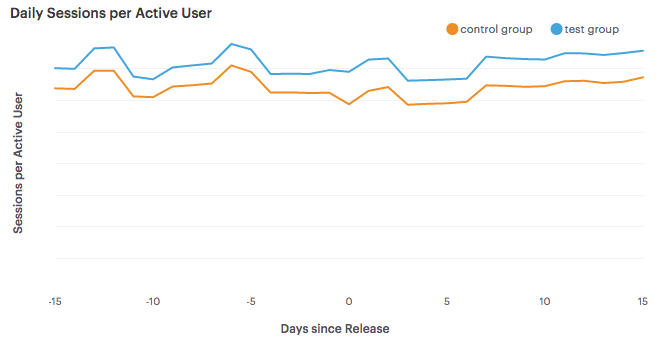
The chart above shows the mean daily sessions per active user for our test and control groups from a staged rollout. We found that users with the new app version were more active than other users prior to the experiment, meaning that a key assumption of A/B testing did not hold: randomized sampling should minimize bias by equalizing all other factors.
Since this assumption did not hold true, we needed to use new techniques in order to measure the performance of our experiments and communicate results to our Product Managers. We want to be able to answer the following questions:
Did the new release have a positive impact on our key metrics?
Is the change significant?
How big is the change?
Typically, we compare the difference between the test and control groups for a time period following the release of the experiment version. To account for the biases in user groups with staged rollouts, we measured key metrics for the experiment groups before and after the new release, and compared the pre-experiment differences between these groups. We use two approaches for this analysis:
Time-Series Analysis
Difference-in-Differences Estimation
We use the first approach to estimate absolute changes in key metrics using aggregate-level data and the second approach to perform significance testing on a collection of metrics using user-level data. Both approaches are used to account for biases in the way that staged rollouts sample users.
Staged Rollout Biases
One of the issues to be aware of when using staged rollouts on Google Play is that it may take several days for users to update to the new binary release (APK). We used a 10% sample rate for our test build, and it took about 2 weeks for users to converge to this value. The chart below shows the adoption rate of the new APK, where adoption rate is defined as the number of users that updated over the total number of active users.
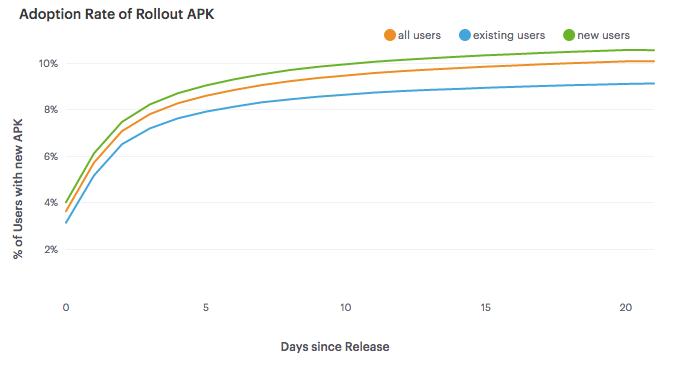
We found that including new users results in a faster adoption rate, but excluded new users in our analysis. The time-series and difference-in-differences methods both rely on data being collected for each user prior to the launch of the experiment, and new users have no prior data. For the experiment detailed later in this post, we only included users that updated within 1 week which resulted in an adoption rate of 8.3%.
In order to try to explain the biases in the data, we explored a variety of variables that may be responsible. The following variables where not significant in determining which groups users were assigned to:
Country
Device Model
The variables that did show biases in the groups were the starting month for the user, and the number of prior updates. A bias towards users that have upgraded more in the past was not surprising, because users need to update in order to be included in the test group.
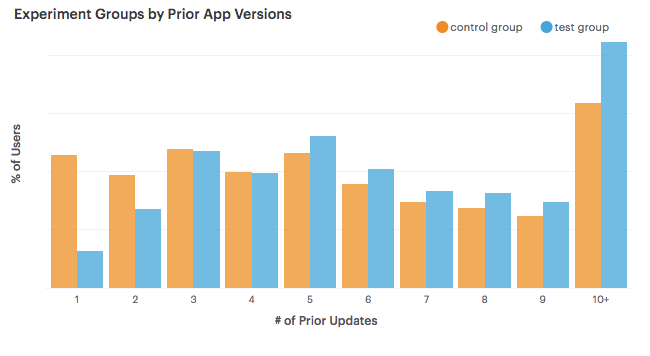
Time Series Analysis
One of the metrics we measured for our staged rollout experiment was the average number of sessions per active user. To estimate the absolute change in this metric between the test and control group we used the CausalImpact R package, which performs Bayesian time-series modeling. This approach estimates the value of the test group’s time series if no intervention occurred, and uses this estimation to provide a prediction of the relative and absolute changes in metrics. A key assumption of this approach is that the control group is not impacted by any changes made.
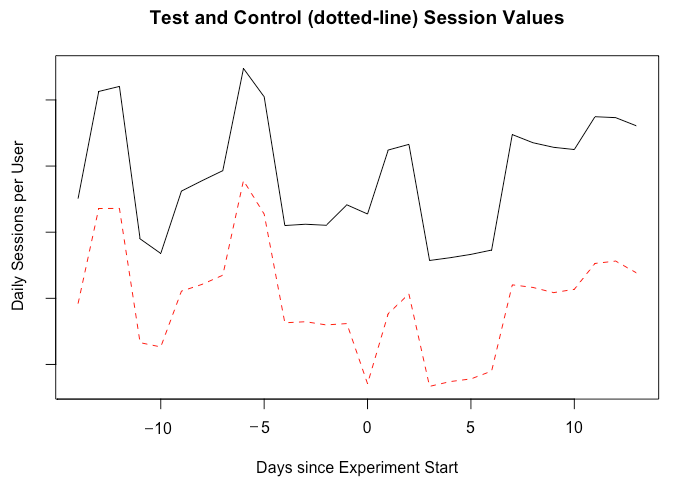
The chart above shows the time series for our test and control groups. The solid line is the average sessions metric for the test group, which was larger than the control group prior to the experiment. We used a two-week period before and after the release date for measuring key metrics.
library(CausalImpact) data <- read.csv(data, file = "DailySessions.csv")
# Create a DataFrame and plot the input data ts <- cbind(data$test, data$control) matplot(ts, type = "l")
# Use two week prior and post periods and plot results pre.period <- c(1, 14) post.period <- c(15, 30) impact <- CausalImpact(ts, pre.period, post.period)
# Plot the results and explain the outcome plot(impact, c("original", "pointwise")) summary(impact, "report")
We used the CausalImpact R package to estimate the impact of the new app version on our session metric. The code snippet above shows how to use this package to build an estimate for the test group. For this experiment, the relative increase was +4% daily sessions per active user, with a 95% confidence interval of [+2%, +5%].
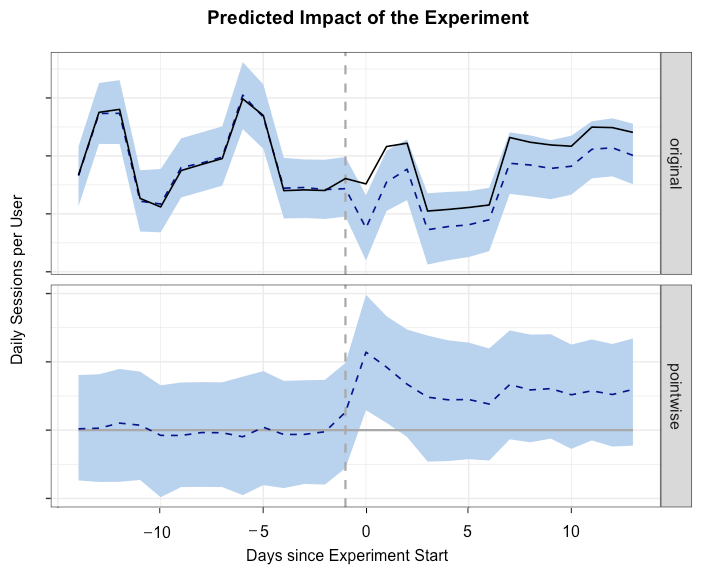
This approach is useful when only aggregate data is available. To test multiple variables independent of a time component, we use bootstrapping.
Difference-in-Differences Estimation
We usually track a collection of metrics when performing experiments at Twitch. Bootstrapping is a robust resampling process that enables our teams to measure changes in metrics with confidence intervals. For our staged rollout experiment, we used bootstrapping to measure the difference-in-differences between our test and control groups.
library(boot) data <- read.csv("UserSessions.csv") # Function for computing the difference of differences run_DiD <- function(data, indices){ d <- data[indices,] new <- mean(d$postval[d$group=='Test'])/ mean(d$priorval[d$group=='Test']) old <-mean(d$postval[d$expgroup=='Control'])/ mean(d$priorval[d$expgroup=='Control']) return((new - old)/old * 100.0) } # perform the bootstrapping and output the results boot_est <- boot(data, run_DiD, R=1000, parallel="multicore", ncpus = 8) quantile(boot_est$t, c(0.025, 0.975)) plot(density(boot_est$t), xlab = "% Increase vs. Control")
For each user, we measured the total number of sessions for the 14 days prior to the test version release and the 14 days following the release date. We then performed thousands of samples, where we computed the mean values for the differences between prior and post values and computed the percent increase between the test and control means. We used the boot R package to perform these calculations, as shown above. The model estimated a +5.4% increase in total sessions per user, with a 95% confidence interval of [+3.9%, +6.9%].
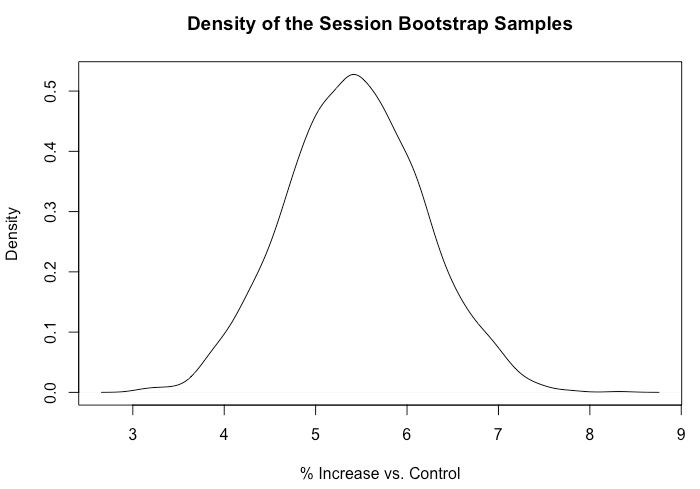
Summary
We found biases in the data when using Google’s staged rollout feature and applied new methods for running experiments with this feature. Both of the approaches used found that the new app release resulted in a significant increase in sessions per user. The time-series method is useful for cases where only aggregate-level data is available, and the bootstrapping approach is useful for testing multiple values independent of a time component. The rollout feature provides a mechanism for testing new builds, but doesn’t work with standard A/B testing approaches. For further reading, explore the following papers on Causal Impact and A/B Testing at Facebook.
The Science Team at Twitch is growing! We’re hiring Data Scientists, Data Analysts, and User Researchers to run experiments and build new features.
Reposted from my Medium Blog.
Read more about:
Featured BlogsYou May Also Like